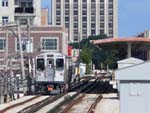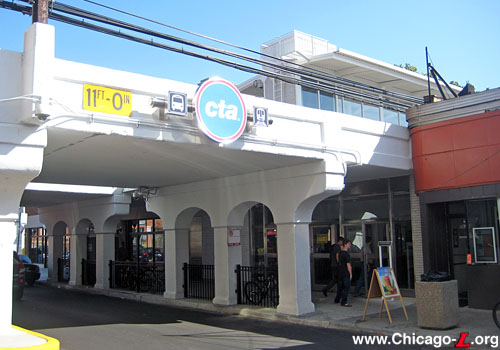
Granville station is seen looking southeast on September 29, 2012. The entranceway under the viaduct, elevator tower, and platform canopy date from the station's 1980 reconstruction and received moderate rehabilitation. A new viaduct-mounted CTA "identifier" provides clear remote identification of the station. For a larger view, click here. (Photo by Graham Garfield) |
Granville
(6200N/1200W)
Granville Avenue and
Broadway, Edgewater
Service
Notes:

|
Red Line:
Howard
|

|
Accessible
Station
|

|
Owl
Service
|
Quick Facts:
Address: 1119 W. Granville
Avenue
Established: May 16, 1908
Original Line: Northwestern Elevated Railroad
Previous Names: North Edgewater
|
Skip-Stop Type:
|

|
Station
|
Rebuilt: 1921, 1980, 2012
Status: In Use
History:
"L" service first entered north Chicago and Evanston by way of an
agreement to use the tracks of the Chicago, Milwaukee and St. Paul
Railway's tracks, replacing the steam service that
the St. Paul had previously provided. The Chicago City Council
authorized the electrification of the tracks of the Chicago,
Milwaukee and St. Paul Railroad's tracks from Graceland Avenue
(Irving Park Road) to the city limits on July 1, 1907. Unlike Evanston (as per the 1907 franchise agreement from the city),
the Chicago City Council did not require that the grade-level tracks
be elevated, but they did prohibit the use of a third rail for
safety's sake, necessitating the use of overhead trolley wire. "L" service north of Wilson to Central Avenue in Evanston began on May 16, 1908.
The St. Paul had a station named North Edgewater at Granville Avenue near Evanston Avenue (now Broadway). The station, of a style typical of railroad depots, was located on the east side of the tracks on the south side of Granville. As they did at the other stations on the newly electrified line, the Northwestern Elevated Railroad chose not to use the station facilities of the St. Paul steam railroad, which were situated and designed for the needs of a main line commuter railroad rather than a rapid transit service. Instead, the Northwestern built a new station at the same location as the St. Paul's station. The "L" station facility at North Edgewater was a
simple ground-level station and modest platform on the south side of Granville Avenue. The station house was
a small, wood frame building set between the two tracks at ground
level with a wooden walkway and stairs leading up to it from the street. The
exterior used clapboard siding and a hipped roof with eaves. The rear
opened out onto an island platform. The platform had a short canopy with a hipped roof (which was actually a continuation of the station house's roof) and center wooden columns with angled brackets, and wood decking.
The station's name changed from North Edgewater to Granville between 1913 and 1917.
Track Elevation and a New Station
In the mid-1910s, the Northwestern Elevated began to elevate the
tracks north from Wilson to Howard, but
work was slow due to the city's refusal to close intersecting streets
and the narrow right-of-way. The elevation work involved complex staging and the temporary relocation of tracks to maintain service while building the new elevated embankment in the same right-of-way. In early 1916, trains were moved onto a
temporary trestle, allowing demolition of the original tracks and stations, but construction of a permanent embankment had to
wait until the end of World War I due to a materials shortage.
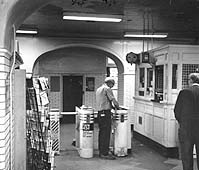
Looking south at
the fare controls of Granville station on
August 18, 1971. For a larger view, click here.
(CTA photo, Graham Garfield Collection) |
With the track elevation came a completely new station. The entrance to the "L" station was located on the south
side of Granville Avenue. The station had a design typical of the
facilities built as part of the Wilson-Howard elevation project.
Designed by architect Charles P. Rawson and engineered by C.F Loweth,
the architectural design was a Prairie School-influenced vernacular
form, with the Prairie influence seen most acutely in the ornamental
cement pilasters on the front facade and in the details of the wooden
doors, windows, and ticket agents' booths. The exterior was brick and
cast concrete with a bedford stone base, wooden doors and large plate
glass windows and transoms. Ornamental globed light fixtures
decorated the pilaster capitals. The station house was centered
within the solid-fill embankment, with retail spaces flanking it on
both sides filling in the remaining width of the embankment.
The interior was rendered in plaster, wood, glazed brick, and
brick with terrazzo floors. There were arches stretching across the
interior between the support columns. In the center of the interior,
passengers found a decorative wooden ticket agent's booth with
ornamental woodwork and a metal grille over the ticket agent's
window. The station also had public restrooms.
There were four tracks through Granville station, but the outer two tracks were for express trains and were not served by the station. A single island platform between the two center tracks served local trains. The platform
had wood decking and a canopy with metal columns down the center line
which split into gently-curving gull wing-shaped roof supports,
supporting a wooden canopy roof. The stairs were sheltered by wooden
enclosures with wooden bottoms and windows on top, divided into rows
of square panes, with swinging doors at the front of each enclosure. Like most of the stations north
of Lawrence, there was originally an
auxiliary exit, located on the north side of the street, descending down in
the middle of retail spaces built under the elevated.
In December 1920, it was reported that the Granville station, along with Argyle, Edgewater Beach, Bryn Mawr, Thorndale, and Jarvis, would be completed by late Spring 1921.1 By
early 1922, the new four track mainline was completed, allowing full
express service to the city limits.
As part of the elevation of the North Side Main Line from Lawrence to Howard,
an interlocking was built north of Granville station with a tower sited at the north end of the station platform. Granville Tower controlled a right-hand crossover from Track 2 (local) to
Track 1 (express) and a left-hand crossover from Track 4 (express) to
Track 3 (local). This interlocking was commonly used to switch Loyola
Express and, in the CTA era Evanston Express trains, which stopped at Loyola for many years, between the local and express tracks. A right-hand
crossover was also located between Tracks 2 and 3, but these were a
hand-throw switches that were not controlled by Granville Tower. On November 24, 1936, one of the "L"'s worst accidents
occurred at Granville Interlocking when a
speeding North
Shore Line train slammed into the rear of the standing "L"
express train. The old
Granville Tower was closed effective February 10, 1975, replaced with a smaller building on the west side of the tracks north of the station.
Station Renovation, Accessibility
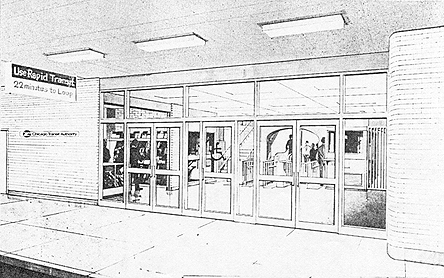
An
architectural drawing of the remodeled Granville station
exterior. The finished product looked almost exactly the
same, executed in tan brick. For a larger view, click here. (Drawing from CTA Transit
News) |
During the 1970s, CTA began planning to renovate Granville station, among others at the north end of the North-South Route. In the late 1970s, the CTA undertook a station modernization program in which they rebuilt or significantly renovated five stations around the system to modern standards and styles. The work tended to include either enlargement of the facilities, or renovations that resulted in improved circulation and capacity. These stations also represented the first modern CTA stations to be equipped with elevators and thus some of the first to be designed to accommodate customers with disabilities, aside from a couple at-grade stations rebuilt with ramps earlier in the 1970s. The
CTA 1980 Historical
Calendar described the station modernization program and its goals:
Featuring an open-plan design
concept, the CTA is rebuilding five major rapid transit
stations which will have escalators and elevators for the
convenience particularly of the elderly and handicapped.
The design provides maximum visibility, easy movement of
people through fare control areas, and a high level of
illumination. Under construction are a new terminal at Desplaines
Avenue, Forest Park, for
service in the Eisenhower Expressway, an enlarged station
at 79th
Street on the Dan Ryan expressway route, elevated stations at Loyola and Granville on the North (Howard) route, and an elevated station at Western
Avenue on the Ravenswood route.
In early 1977, the CTA awarded the design contract for the new
Granville station, as well as the new Loyola station, to the firm of Dubin, Dubin, Black and
Moutoussamy for an amount not to exceed $202,369.
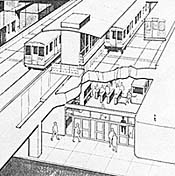
An
architectural cutaway of the remodeled Granville station.
For a larger view, click here. (Drawing from CTA Transit
News) |
The CTA was limited in its reconstruction of the station due to being constrained on all sides by streets, the solid-fill viaduct (which was not reconstructed), and adjacent buildings. However, the station house was completely gutted, stripped back to the structural shell, and rebuilt with a new layout and circulation pattern, and new fixtures and finishes. The wall surfaces, both inside and on the exterior, were clad in tan brick. On the street elevations, large picture windows were installed between the piers to provide maximum natural light, airiness, and visibility for safety. The arches between piers inside were left unclad. The new station house had a somewhat more open feeling in the fare control area, and a ticket agent's booth and turnstiles arranged to maximize flow and circulation.
The platform was completely reconstructed and moved south of Granville Avenue. The new platform had a concrete deck with gray granite tiles along the trackside edges. The new canopy covered the entire length and was supported by a single row of white-painted steel I-beams down the middle of the platform. The corrugated metal canopy roof was supported by curved beams. The new windbreaks and other fixtures were all built of white-painted tubular steel.
In
May 1978, the CTA awarded a contract for $1,119,440 for rebuilding the
Granville station to the Ross, Lynn &
Norman Construction Company of Skokie. Ross, Lynn and Norman also reconstructed the stations one stop north at Loyola and at Western on the Ravenswood Line around the same time. Work was staged over a few years to keep the station operational while work was underway. Although the new platform was moved south of the old one, the two overlapped for a few hundred feet or so. To accommodate construction, a temporary extension was built at the north end of the platform, allowing the south end to be vacated for demolition. To accommodate renovation of the station house, the main entrance was closed on August 21, 1978 and temporary fare controls were added to the auxiliary entrance/exit on the north side of Granville Avenue, which served as the station's entrance during construction. On November 11, 1980, the rebuilt Granville station opened, with the new elevator in operation. Granville's elevator was first added to an "L" station by the CTA. With the renovated station house and new platform open, the old platform was demolished and the entrance/exit on the north side of Granville closed and removed.
Station Changes
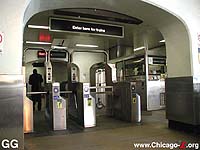
Looking south at
the fare controls of Granville station on March 12, 2002. Although the station was
heavily modified in 1980, the basic shape of the
interior remains. For a larger view, click here. (Photo by Graham Garfield) |
In early March 2002, Granville received new station name
signs, though not in the form of replacements but in
addition to the existing station name signs. The new Green Line Graphic
Standard station name signs were installed in addition
to the existing signs that date from the station's
reconstruction in 1980. The new signs were located on new tan
steel poles and brackets mounted on the embankment wall
between the tracks and the alleys adjacent to the solid-fill
embankment of the North Side Main Line, thus placing them
facing the platforms rather than on them. These new signs
were similar to new ones installed at Sox-35th and 95th/Dan Ryan in November
2001.
Following complaints from community members and local
aldermen Joe Moore at a
CTA annual budget
hearing, viaduct renewal was programmed for Granville and Morse, along with some modest
station improvements at Morse. At
each bridge, deteriorated concrete on the decking and
abutments were to be replaced, the bridge deck was to be
waterproofed and resealed, and the trackbed and trackwork
over the bridge replaced.
Patching of the spalling concrete on both the Morse and Granville viaducts began in
late September 2004 and viaduct work was completed at Granville in October 2004, with
punchlist work completed in January 2005. The contractor was
Kiewit-Western.
In 2006, the station name signs and column signs on the
platform were replaced, with Green Line
Graphic Standard signs replacing the KDR
Standard graphics, and new entrance signs installed as
part of a signage upgrade project on the Red Line. As part
of this effort, the station also received granite compass
roses inset into the sidewalk in front of the station
entrance to assist customers leaving the station to navigate
their way, and three-sided galvanized steel pylons in the
station house and on the platform to display maps and
station timetables.
North Red Line Life-Extension Renovations
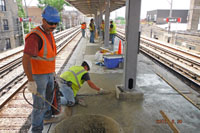
Contractors work to smooth out new poured concrete where sections of the platform were replaced at Granville, seen looking south on June 30, 2012. For a larger view, click here. (Photo courtesy of the CTA) |
By the early 21st century, the stations, track, and elevated infrastructure on the north Red Line, between Wilson and Howard, were in severe need of rehabilitation, both to maintain a good state of repair as well as to modernize certain systems and amenities. The scale of the work and the funding necessary to undertake it were large enough that a broad study and planning effort were needed to properly scope the work and apply for sufficient funding. While this study was undertaken, and due to the presumed amount of time it would take to complete the study, secure funding, and complete design engineering, the CTA felt it was necessary to undertake modest-scale renovations in the meantime to extend the life of the existing infrastructure.
On February 8, 2012, the Chicago Transit Board approved the awarding of a design/build contract to Kiewit Infrastructure Co. to rehabilitate seven rail stations on the North Main Line section of the Red Line: Jarvis, Morse, Granville, Thorndale, Berwyn, Argyle and Lawrence. The work would provide a life-extension for the seven stations until a long-term capital improvement plan is determined for this portion of the Red Line as part of the Red-Purple Modernization Project (see below). "These interim improvements are important because we cannot postpone repairs which need our immediate attention. The CTA wants to be good stewards of the infrastructure we have now, as we continue to plan for the future and pursue additional funding," said CTA President Forrest Claypool. "This contract will allow us to quickly address some much needed capital maintenance work, while also improving the quality and experience for our riders and neighbors."
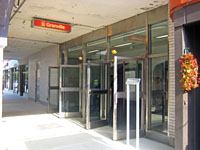
The front entrance to Granville station is seen looking southeast on July 14, 2012, its first full day back in service (it reopened at 10pm the previous day) after being closed for six weeks for renovation. Having been extensively renovated over 30 years earlier, the exterior entranceway was not extensively changed, but received some refurbishment, masonry cleaning, and tuckpointing. The underside of the viaduct and other surrounding areas were still being worked on after the station reopened. For a larger view, click here. (Photo by Graham Garfield) |
Kiewit Infrastructure Co. was awarded the contract to through a competitive bid process. Design work began in Spring 2012. Per the terms of the contract, construction was to conclude in early 2013 (though most work was actually completed by the end of 2012) and was not to exceed $57.4 million for services, labor and materials.
Construction plans included temporary station closures for no more than six weeks. Adjacent stations were not closed simultaneously. To minimize impact to customers, service reroutes were scheduled for overnight and weekends only.
Improvement work at each location included renovations to the station facilities, the viaduct, and the tracks. At Granville, the work was somewhat less extensive than it was at the other six stations, as Granville has been extensively renovated just over 30 years previous, compared to the other stations which hadn't seen significant renovations since being built over 90 years before. The station house exterior received masonry cleaning and repairs and new tuckpointing, as well as new windows, doors and exterior lighting . Inside, the existing masonry was cleaned and tuckpointed, and the concrete walls and ceiling were repaired, resurfaced, and repainted. A new concrete floor was installed and existing stainless steel fixtures and finishes that were retained were cleaned and polished. Lighting and signage was replaced. Outside of the station house, sidewalk repairs were performed and new bike racks installed. On the platform, the steel canopy that was built circa 1980 was retained but refurbished and repainted. The platform foundations were replaced. The sections of the concrete platform was also replaced with new poured concrete deck, largely in the areas around the canopy columns where the new foundation required the deck to the demolished. The platform signage was replaced, as were the windbreaks, benches, and other furnishings. The glass curtain walls on the west side of the stairs and escalator between the platform and station house were extended up to the canopy roof to provide additional weather protection. The stairs were refurbished with new ceramic tiles and stainless steel handrails. A new communications system was also installed at the station.
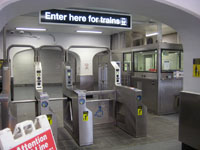
The refurbished Granville station house interior is seen looking south at the turnstiles and Customer Assistant booth from the unpaid area on July 14, 2012. The interior was refurbished and the lighting and signage replaced with LED-lit fixtures. For a larger view, click here. (Photo by Graham Garfield) |
The viaduct at Granville also received some improvement work, though less than at other stations due to Granville's having been rehabilitated with new waterproofing and concrete repairs in 2004-05. The Granville viaduct received painting/coating and new, brighter lighting under the viaducts. New track, ties, and ballast were laid through the station area during the project.
Installing elevators to make all the stations wheelchair-accessible is not part of the short-term project.2 Work is also planned for the roofs of adjacent station buildings, so that inside concession spaces can be leased and begin to generate revenue for the Authority.3
Granville temporarily closed for renovation at the end of the day June 1, 2012. The station reopened following renovation at 10pm, Friday, July 13, 2012. The majority of the station improvement work took place during the six-week closure. However, improvements to the viaduct and tracks took place over a longer period during the project.
To improve the station's visibility, a station "identifier" was included in the project. Mounted to the viaduct, the identifier includes a large CTA logo centered on a horizontal pole to attract attention from afar and provide remote identification of the station's location -- akin to the famous roundel that marks the entrance to London Underground tube stations. The CTA logo is flanked by bus and train symbols, denoting the transit services available at or adjacent to the station. Granville's CTA identifier was the first of the viaduct-mounted type to the installed on the system, and the second overall to be installed after the backlit pole-mounted type added to the Roosevelt subway station in 2007. The identifiers at Granville were installed in mid-September 2012.
Funding for the station rehabilitation project is from the Federal Transportation Administration (FTA) and is part of the $1 billion Red Line investment project. The $1 billion capital investment is a combination of state, local and federal funds, which will support other Red Line projects including track and station renewal along the Dan Ryan branch; the renovation of the Clark/Division and Wilson stations; and several other track, substation and station renewal projects along the North Side Main Line.
Red-Purple Lines Modernization (RPM) Project
Due to the deteriorating condition of the infrastructure on the Red Line north of Belmont and on the Purple Line, the CTA initiated the Red-Purple Modernization Project (RPM) to bring the existing transit stations, track systems, and structures into a state of good repair. The project, which stretches along the existing Red and Purple lines from north of Belmont station to Linden terminal, would help bring the existing transit line into a state of good repair, reduce travel times, improve access to job markets and destinations, and provide improved access to people with disabilities.
The project began in 2009 with a vision study to assess the scope of needs and develop a set of alternatives for study. In 2010, in accordance with the National Environmental Policy Act (NEPA), CTA and Federal Transit Administration (FTA) initiated the environmental review process for the project and undertook work to develop an Environmental Impact Statement (EIS). The process included numerous public meetings and input opportunities, and study of various alternatives for achieving a good state of repair for the infrastructure in the project area.
A number of alternatives are under consideration for the RPM project, including the comprehensive reconstruction of track, stations, and structures along the line. The four options currently under consideration and study, not including an FTA-required "no action" baseline scenario, include:
- Basic Rehabilitation: provides a strategic mix of repairs, rehabilitation, and replacement of the existing infrastructure for a useful life of 20 years, plus the addition of a transfer station at Loyola; all station locations remain the same.
- Modernization with Station Consolidation: provides a brand new elevated structure between Lawrence and Howard, modern amenities at stations, increases speed of service, includes new transfer station at Loyola, and major reconstruction and renovation to extend the useful life to 60-80 years; several stations would be consolidated by closing one station and adding a second entrance at an adjacent station.
- Modernization without Station Consolidation: provides a brand new elevated structure between Lawrence and Howard, modern amenities at stations, modest increase in speed of service, includes new transfer station at Loyola, and major reconstruction and renovation to extend the useful life to 60-80 years; all station locations remain the same.
The Modernization with Station Consolidation option includes the consolidation of Thorndale station with the Granville and Bryn Mawr stations by closing the existing Thorndale station and adding entrances to Granville and Bryn Mawr -- at Glenlake Avenue for Granville station, approximately one block north of Thorndale station and one block south of Granville station.; and at Hollywood Avenue, approximately two blocks south of Thorndale station and one block north of Bryn Mawr station.
Other alternatives considered earlier in the study but subsequently eliminated due to public comment and further study included basic rehabilitation without adding a transfer station at Loyola, a modernization option with only three tracks between Lawrence and Howard, and a modernization option with a 2-track subway under Broadway.
The full-scale modernization envisioned on the Red-Purple Modernization Project could cost anywhere from $2.5 to $5 billion. On February 8, 2012, the CTA board retained Goldman Sachs & Co. to lead the search for public-private partnerships to help finance the reconstruction, which has no firm date. Goldman Sachs will work with Chicago-based Loop Capital Markets LLC and Estrada Hinojosa & Co., but will accept no fee for the first year as it determines the ability to raise private capital.
See CTA's Red & Purple Modernization page for more information about the scoping and planning process, and the various alternatives being considered.
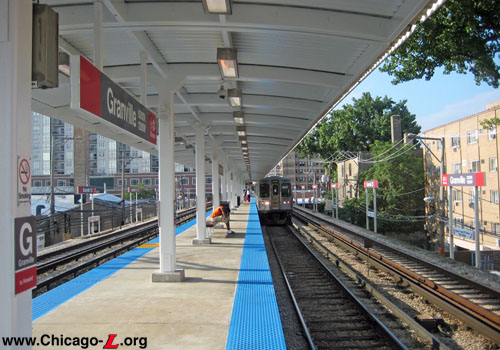
The renovated island platform at
Granville is seen looking north on July 14, 2012, the first full day of service after having reopened at 10pm the night previous. The unadorned white steel columns, crossbeams, and
arched canopy provide a clean and simple design typical of stations built around 1980. The station received a six-week refurbishment which included new platform foundations, some new decking, a repainted canopy, and new signage. Note the train on northbound Track 3 in the station, with both headlights and taillights illuminated and "Express" signs -- it is not a northbound Red Line train, but rather a shuttle running bidirectionally on Track 3 as part of a reroute for viaduct construction farther up the line at Jarvis. Both sets of lights are lit because the train is on the cab signal (ATC) bypass so it can run against traffic on Track 3. For a
larger view, click here.
(Photo by Graham
Garfield) |


|
ctaS-353.jpg (140k)
Ex-4314 work motor S-353 is at Granville station -- six
years before being rebuilt -- on August 7, 1974. Only one of
the dual trolley poles is actually for drawing power: the
second pole, over the motorman's cab, is a sleet scrapper.
The scrapper and snow plow make S-353 a powerful
winter-fighting unit! (Photo by Doug
Grotjahn, Collection of Joe Testagrose) |
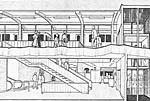
|
granville-drwng2.jpg
(68k)
An architectural profile of the remodeled Granville
station. The finished product looked almost exactly the
same. The elevator, seen at right, was uncommon at the time,
as were escalators in stations, seen tucked away on the
left. Its interior and canopy architecture resembles Loyola, one stop
north.
(Drawing from CTA Transit
News) |
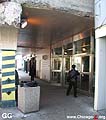
|
granville01.jpg
(152k)
The front entrance to the station on the south side of
Granville Avenue, looking east on March 12, 2002. In the
1980 renovation, the front facade was completely removed and
a plain tan brick front with stainless steel doorway added.
This facility is still in use today. (Photo
by Graham Garfield) |
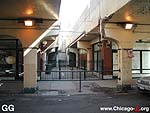
|
granville02.jpg
(124k)
Granville, like all stations on the North Side Main Line
north of Wilson, had an auxiliary
exit from the platform to the opposite side of the street
from the main station entrance. Granville was no exception,
though like most of the other stations it has since been
closed and removed. This view, looking north across
Granville Avenue on on March 12, 2002, shows the former
location of the auxiliary exit stairs up to the platform.
The brick facades also show the station's original exterior
architectural design. (Photo by Graham
Garfield) |
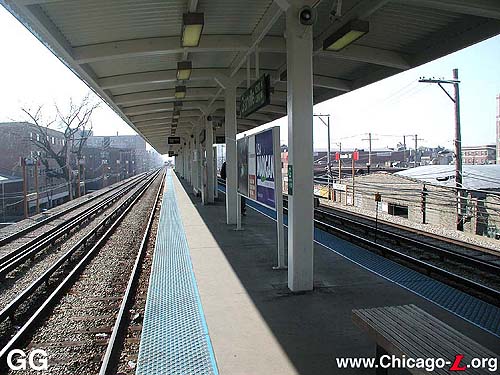 |
granville04.jpg (149k)
The island platform at Granville, as rebuilt in 1980, looking south on March 12, 2002. The unadorned white steel columns, crossbeams, and arched canopy provide a clean and simple design. (Photo by Graham
Garfield) |

|
granville05.jpg
(120k)
Looking south on the Granville platform on March 12,
2002. Like many rebuilt stations, the windbreaks and signage
were incorporated into the design rather than tacked on
later. This is usually a worthwhile effort when the station
opens, but can create problems down the road. For instance,
the "Board Here / Pay on Train" sign is now superfluous, as
there is no on-train fare collection any more, and the
Granville station name sign needs to be replaced with a new
design (see below). Removing these signs will be more
difficult than normal, however, because of how they are
mounted. (Photo by Graham
Garfield) |
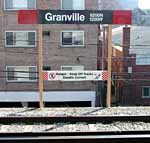
|
granville06.jpg
(183k)
Granville received new Green Line
Graphic Standard station name signs in early March 2002,
mounted on new brackets along the edge of the embankment
wall, outside the tracks. This sign is outside the
northbound express track (track 4), looking east on March
12, 2002. (Photo by Graham
Garfield) |
|
cta5012c.jpg (210k)
The two-car 5000-series prototype unit 5011-12 is seen undergoing testing on Track 1 midday on October 20, 2009, as 5012 leads the train heading south past Granville station. (Photo by Noel Angelo Centeno) |
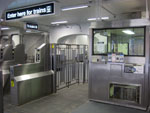 |
granville11.jpg (183k)
The interior of the refurbished Granville station is seen looking southeast from the unpaid area on July 14, 2012. The Customer Assistant booth was installed in the circa 1980 renovation of the station, built for ticket agents. The interior walls and surfaces were refurnished, while the electric signs were replaced with new boxes using LED lighting and new sign faces. (Photo by Graham
Garfield) |
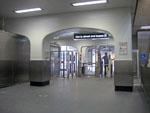 |
granville12.jpg (159k)
The paid area of the refurbished Granville interior is seen looking north on July 14, 2012. The station's paid area has a lot of room for circulation compared to the unpaid area. The wall surfaces were refinished and repainted, and the lighting was replaced. The backlit signs were replaced with new LED-lit fixtures. The stainless steel fixtures were cleaned and polished. (Photo by Graham
Garfield) |
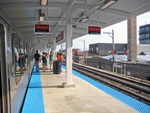 |
granville14.jpg (248k)
Granville station's renovated island platform is seen looking north on July 14, 2012. Sections of the concrete platform deck were replaced, and the canopy was cleaned and repainted. Signage was replaced, and the existing backlit sign boxes were relamped with new, efficient fixtures. (Photo by Graham
Garfield) |
 |
granville16.jpg (174k)
A viaduct-mounted CTA "identifier" beckons passengers to Granville station as a 95th-bound train passes overhead on September 29, 2012. The identifier includes a large CTA logo centered on a horizontal pole to attract attention from afar and provide remote identification of the station's location -- akin to the famous roundel that marks the entrance to London Underground tube stations. The CTA logo is flanked by bus and train symbols, denoting the transit services available at or adjacent to the station. Granville's CTA identifier was the first of the viaduct-mounted type to the installed on the system. (Photo by Graham
Garfield) |

|

|
Notes:
1. "3 NEW STATIONS ON NORTH SIDE "L" READY JAN. 1." Chicago Daily Tribune, 1920 Dec. 1, pg. 21.
2.Hilkevitch, Jon. "$57.4 million facelift program OK'd for 7 North Side stops on CTA's Red Line." Chicago Tribune. 8 February 2012.
3. Roberts, Bob. "Major Renovations Coming To Multiple Red Line Stations." CBS Chicago. 9 February 2012.



















